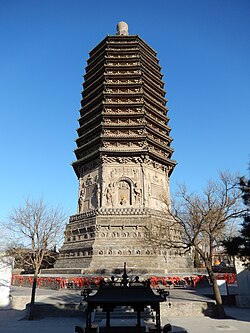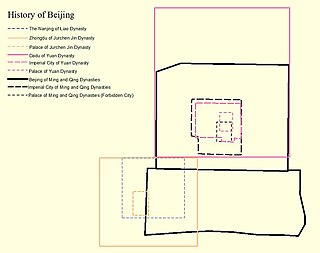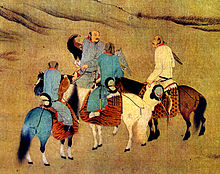
The Jin dynasty, officially known as the Great Jin, was an imperial dynasty of China that existed between 1115 and 1234. Because the Wanyan clan that founded the dynasty were of Jurchen descent, it is also sometimes called the Jurchen dynasty or the Jurchen Jin.

The Qara Khitai, or Kara Khitai, also known as the Western Liao, officially the Great Liao, was a dynastic regime based in Central Asia ruled by the Yelü clan of the Khitan people. Being a rump state of the Khitan-led Liao dynasty, Western Liao was culturally Sinicized to a large extent, especially among the elites consisting of Liao refugees.
Emperor Shengzong of Liao, personal name Wenshunu, sinicised name Yelü Longxu, was the sixth emperor of the Khitan-led Chinese Liao dynasty and its longest reigning monarch.
Emperor Tianzuo of Liao, personal name Yelü Yanxi, courtesy name Yanning, was the ninth and last emperor of the Khitan-led Liao dynasty of China. He succeeded his grandfather, Emperor Daozong, in 1101 and reigned until the fall of the Liao dynasty in 1125.
Yelü Dashi, courtesy name Zhongde (重德), also known by his temple name as the Emperor Dezong of Western Liao (西遼德宗), was the founder of the Western Liao dynasty. He initially ruled as king from 1124 to 1132, then as emperor from 1132 to 1143. He was also known in Muslim sources as Nūshī Taifū, Qushqin Taifū or Qushqīn, son of Baighū. He fled the Liao dynasty in northern China as it was on the verge of destruction by the Jurchen-led Jin dynasty and moved westward into Central Asia where he established a new empire.

The Jingkang Incident, also known as the Humiliation of Jingkang and the Disorders of the Jingkang Period, was an episode of invasions and war crimes that took place in 1127 during the Jin–Song Wars when the forces of the Jurchen-led Jin dynasty besieged and sacked the imperial palaces in Bianjing, the capital of the Han-led Northern Song dynasty. The Jin forces captured the Northern Song ruler, Emperor Qinzong, along with his father, the retired Emperor Huizong, and many members of the imperial family of Emperor Taizong's bloodline and officials of the Song imperial court. The ordinary Song civilians of Bianjing living in the non-imperial quarter were left alone after being forced to pay huge ransoms to the Jin.

Yelü Chucai, courtesy name Jinqing, was a Khitan statesman from the imperial clan of the Liao dynasty, who became a vigorous adviser and administrator of the early Mongol Empire in the Confucian tradition. He was the first of Genghis Khan's retainers to formulate policy during the Mongol invasions and conquests, and he also introduced many administrative reforms in North China during the reign of Genghis Khan and his successor Ögedei.
The city of Beijing has a long and rich history that dates back over 3,000 years.
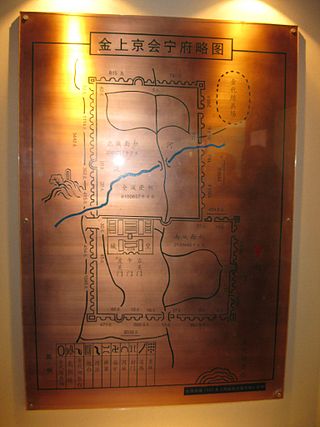
Huining Fu, or Shangjing Huiningfu, was a Fu in the Shangjing region of Northeast China. It served as the first superior capital of the Jurchen-led Jin dynasty (1115-1234) from 1122 to 1153. Its location was in present-day Acheng District, Harbin, Heilongjiang Province.

The Sixteen Prefectures of Yanyun comprise a historical region in northern China along the Great Wall in present-day Beijing, Tianjin, and part of northern Hebei and Shanxi. It was a site of constant military and political conflict between various dynasties from the end of the Tang dynasty until the establishment of the Yuan dynasty.
Yelü Bei, also known as Yelü Tuyu, posthumously honored Emperor Wenxian Qinyi (文獻欽義皇帝) with the temple name Yizong, formally known as Renhuang Wang during his lifetime, known as Dongdan Muhua (東丹慕華) (931) and then Li Zanhua (李贊華) (931–937) as a Later Tang subject, was the eldest son of Emperor Taizu of Liao, the founder of the Liao dynasty. He was declared successor to the Emperor Taizu in 916, but never succeeded to the throne. Rather, after the accession of his younger brother Yelü Deguang, he fled to the Shatuo-led Later Tang dynasty, where he was killed in 937.
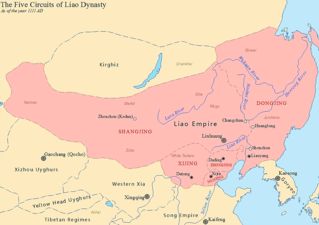
The Liao dynasty, also known as the Khitan Empire, officially the Great Liao, was an imperial dynasty of China that existed between 916 and 1125, ruled by the Yelü clan of the Khitan people. Founded around the time of the collapse of the Tang dynasty, at its greatest extent it ruled over Northeast China, the Mongolian Plateau, the northern part of the Korean Peninsula, southern portions of the Russian Far East, and the northern tip of the North China Plain.
The Northern Liao, officially the Great Liao, was a dynastic regime of China, distinct from the Liao dynasty, established by the Khitan Yelü clan in northern China. The state only existed for a short period of time between 1122 and 1123.
The Battle of Gaoliang River was fought in 979 between the Liao dynasty and Northern Song dynasty in present-day Beijing. The Liao victory ended a Song campaign to recapture the Sixteen Prefectures in North China.

"Beijing" is from pinyin Běijīng, which is romanized from 北京, the Chinese name for this city. The pinyin system of transliteration was approved by the Chinese government in 1958, but little used until 1979. It was gradually adopted by various news organizations, governments, and international agencies over the next decade.
Ji or Jicheng was an ancient city in northern China, which has become the longest continuously inhabited section of modern Beijing. Historical mention of Ji dates to the founding of the Zhou dynasty in about 1045 BC. Archaeological finds in southwestern Beijing where Ji was believed to be located date to the Spring and Autumn period. The city of Ji served as the capital of the ancient states of Ji and Yan until the unification of China by the Qin dynasty in 221 BC. Thereafter, the city was a prefectural capital for Youzhou through the Han dynasty, Three Kingdoms, Western Jin dynasty, Sixteen Kingdoms, Northern Dynasties, and Sui dynasty. With the creation of a Jizhou (蓟州) during the Tang dynasty in what is now Tianjin Municipality, the city of Ji took on the name Youzhou. Youzhou was one of the Sixteen Prefectures ceded to the Khitans during the Five Dynasties. The city then became the southern capital of the Liao dynasty and then main capital of the Jin dynasty (1115–1234). In the 13th century, Kublai Khan built a new capital city for the Yuan dynasty adjacent to Ji to the north. The old city of Ji became a suburb to Dadu. In the Ming dynasty, the old and new cities were merged by Beijing's Ming-era city wall.
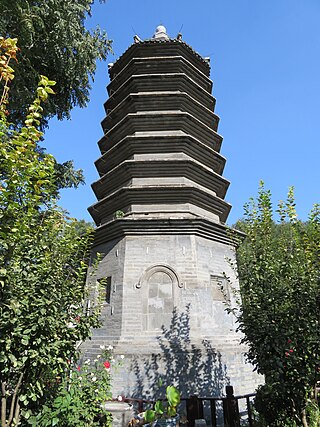
Wansong Xingxiu or Wansong Yelao (1166–1246) was a Chinese Buddhist monk who lived under the Jin dynasty and Mongol Empire. He was an influential member of the Caodong school of Chan Buddhism.
Eastern Liao was a 13th-century kingdom in what is now Northeast China, established by the Khitan Yelü clan in an attempt to resurrect the Liao dynasty. Its capital was situated in modern-day Kaiyuan, Liaoning.
Xiao Hunian, also known as Hehan (和罕) was a Khitan noble lady of imperial China's Liao dynasty. She was one of the Xiao sisters and the oldest sister of Lady Xiao and Xiao Yanyan.
Han Derang, known for his Khitan name, Yelü Longyun, Xingning, or Yaoge was a Chinese politician. He served as the Prime Minister of Liao Dynasty during the reign of Empress Xiao Chuo. He was a native of Hebei Yutian (祖籍河北玉田) and born into the Shihou Family.
